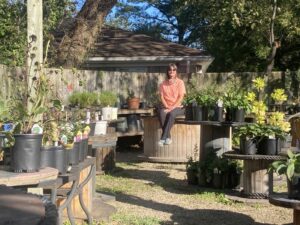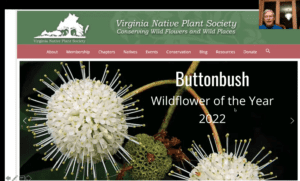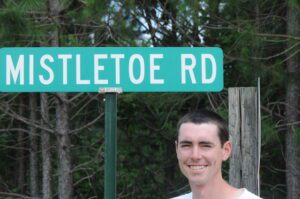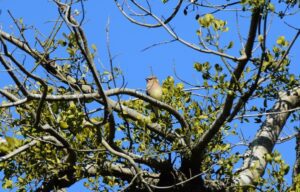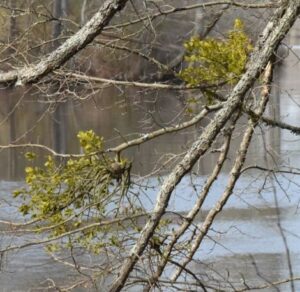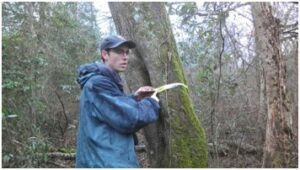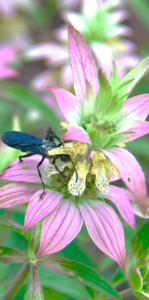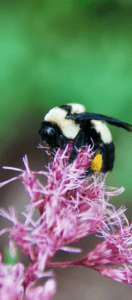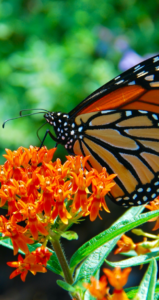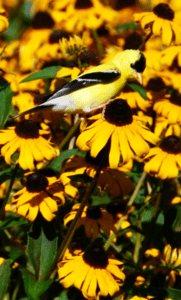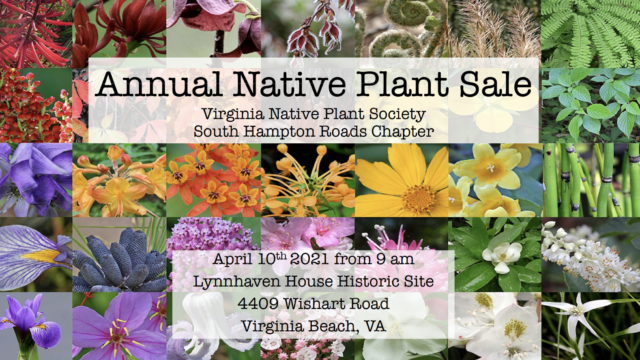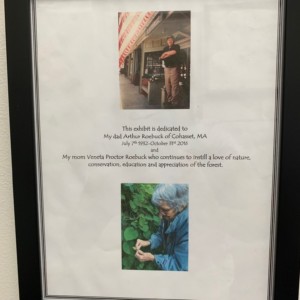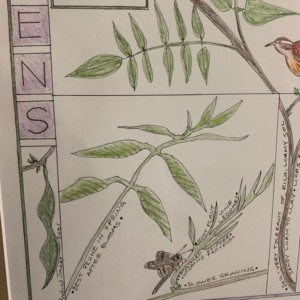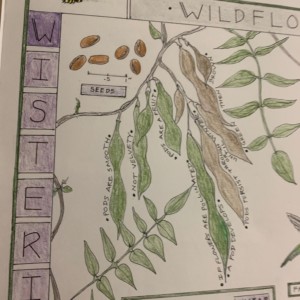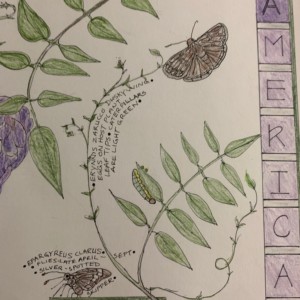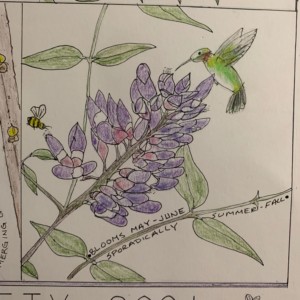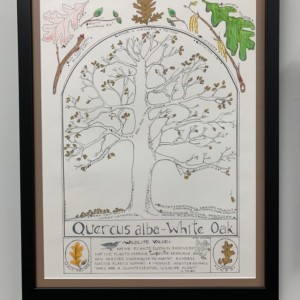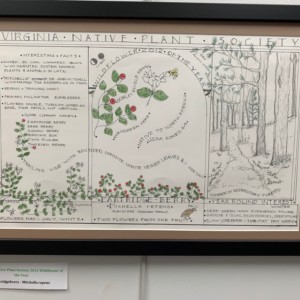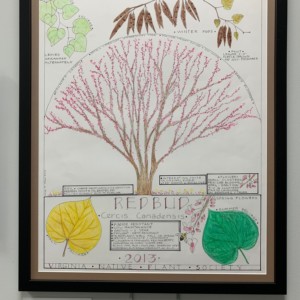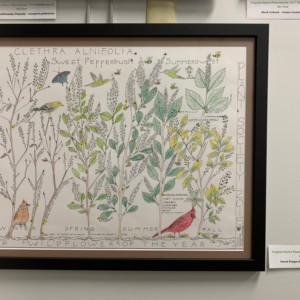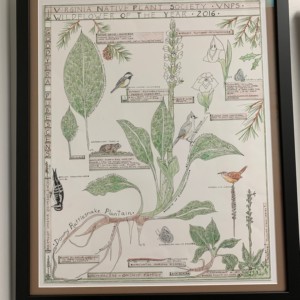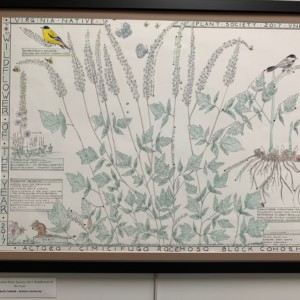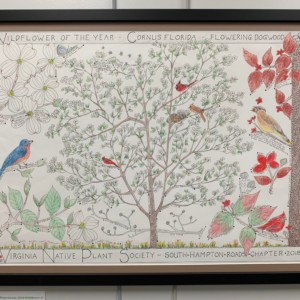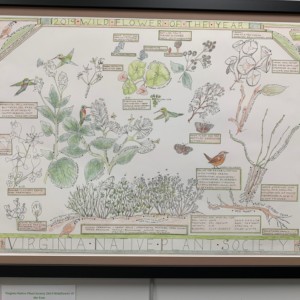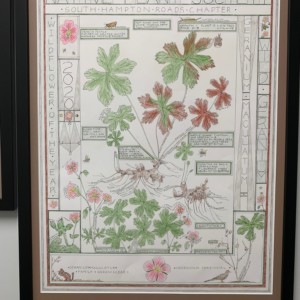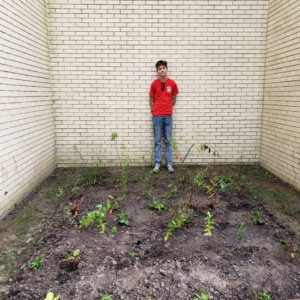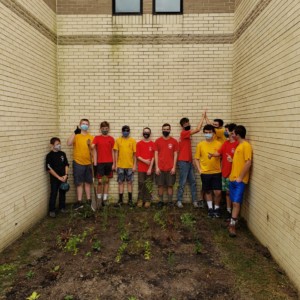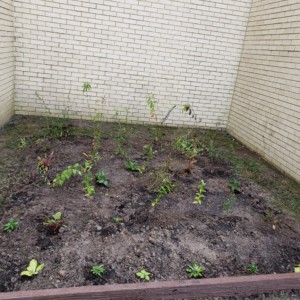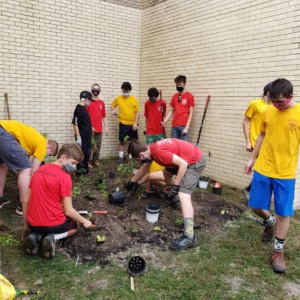February 2002: “Virginia Coastal Plain Native Plants for Pollinators”, by Nicole Knudson
Nicole Knudson is the owner and operator of Lady Fern’s Native Plants on North Colley Avenue in Norfolk. She holds a bachelor’s degree in biology and has been a university and community college student many times since earning her degree. Nicole is a long-time Hampton Roads native with 15 years of experience in horticulture and as a Master Gardener. She worked for DCR-Natural Heritage assisting the Field Botanist to inventory rare native plants across Virginia. Several of her photos of natives are featured on the Flora of Virginia app and the Digital Atlas of the Virginia Flora. In 2019, Nicole obtained property on the Eastern Shore in Machipongo to grow and propagate native plants and in 2020 began sales at her retail garden center, Lady Fern on Colley Avenue in Norfolk.
#-----------------------------------------------------------------------------------------------------#
January 2022: History of Virginia Native Plant Society by Steve Stasulis, former VNPS South Hampton Roads Past President.
Virginia Native Plant Society was established in 1982 by Mary Painter who owned a nursery in Hume, VA. Patterned after the California Native Plant Society, Conservation Places Originally named ??? is became the Virginia Native Plant Society in 1989 with the motto, “Conserving wildflower and wild places.” Amateurs and professionals alike were welcome. Present day office is located in Boyce, VA at the Commonwealth Arboretum. Only one paid ½ time office manager handles state membership, correspondence, bookkeeping, quarterly bulletin, publications, workshops, annual meetings, field trips and insurance; Ms. Karen York.
Steve Stasulis, former VNPS-SHRC president, spoke about the Virginia Native Plant Society history.
Today there are 11 chapters (Blue Ridge, Jefferson, John Clayton, New River, Prince William, South Hampton Roads, Upper James River, Northern Neck, Pocahontas, Piedmont, Potomac) across the state with over 2000 members. Membership donation is split 65% to the state organization and 35% to chapters. Pre-Covid, there were annual meetings in September (except for Hampton Roads, we moved the meeting to non-hurricane season), with host duties rotated to each chapter around the state and educational field trips to other places (Texas, Canada, Kansas, Illinois, etc). The Society is supported by membership fees, donations, Spring Workshop fees. Spring Workshop is an annual meeting that was held at the University of Richmond, but now in Charlottesville for use of larger facilities. Usually, four speakers will instruct on a theme/topic for the workshop.
At the state level, there are Special Chair Offices: Botany, Conservation, Education, Fund Raising, Horticulture, Membership, Publications, Registry (where landowners commit to leaving undeveloped areas in their borders). These are the members of the board who decide upon the “Wildflower of the Year”. Horticulture has been pressing for nurseries in Virginia to shop selling non-native invasive plants.
The South Hampton Roads Chapter includes Chesapeake, Isle of Wight, Norfolk, Portsmouth and Virginia Beach
The South Hampton Roads (SHR) Chapter includes Chesapeake, Isle of Wight, Norfolk, Portsmouth, Suffolk, Virginia Beach. Meetings usually take place at Norfolk Botanical Garden on the 4th Thursday evening of the month. Cash flow inbound comes from 35% of membership dues, donations, plant sale profits. Expenses: mailings, speakers, plant purchases, splits with internal vendors, printing costs, Zoom costs, internet fees, software, VNPS-SHR signs, donations to other organizations ($1600 donated in 2021 to several organizations including Elizabeth River Project, Lynnhaven River NOW and Chesapeake Bay Foundation). Plant sale is quite affordable, as 1-gallon plants are still priced around $7 and plugs $3, which has been the same for about the last 15 years.
#-----------------------------------------------------------------------------------------------------#
November 2021: “The Ecology of the Oak Mistletoe, Phoradendron leucarpum, in Eastern Virginia & North Carolina” by Nicholas P. Flanders, PhD
On Thursday, November 18th at the Norfolk Botanical Garden,we had invited for our monthly speaker, Nick P. Flanders began birding in high school in Newport News, VA, during which time members of the Hampton Roads Bird Club and Cape Henry Audubon Society introduced him to many beautiful and biodiverse areas in Hampton Roads and beyond.
Nick’s natural history interests broadened while pursuing undergraduate studies at Old Dominion University and taking field botany courses with Dr. Lytton Musselman. He completed his BS at Old Dominion University and holds an MS in Fisheries, Wildlife, and Conservation Biology from North Carolina State University.
He is presently a PhD candidate at Old Dominion University where he has been researching the role of birds in the biology of the Eastern mistletoe (Phoradendron leucarpum). In 2017 he received the award for best graduate student presentation in ecology at the annual meeting of the Botanical Society of America for his work on mistletoe.
Nick is a Board Member of Cape Henry Audubon Society. He is a co-compiler along with Elisa Flanders in the annual Christmas Bird Counts: this year for the December 31, 2021 Little Creek CBC.
Nick has also worked extensively at the Blackwater Preserve in Isle of Wight Co., VA and is co-author on a paper in press on spatial and morphological relationships of Longleaf pine at the Preserve." He presented his research work titled: The Ecology of the Oak Mistletoe, Phoradendron leucarpum, in Eastern Virginia & North Carolina.
Nick gave an introduction on what got him interested in wildlife and ecology. Mistletoe parasitizes via its root system. It is described as an obligate aerial hemiparasite in the plant Order Santalales, a functional group like the mangroves. P. leucarpum parasitizes varieties of angiosperm tree species that are primarily deciduous. It’s an evergreen shrub that is dioecious and seed dispersal occurs via birds. (In the northern part of North America, there is a species of mistletoe that parasitizes pines, but it uses explosive seed dispersal.)
Mistletoe has many interactions with birds worldwide. The obligate aerial hemiparasites evolved independently several times as demonstrated by genetics studies. The tropical types often have showy flowers. In New South Wales in Australia large scale mistletoe removal resulted in 20.9% drop in bird variety richness. In the southwest of North America, the Phainopepla bird Phainopepla nitens has a mutualism type relationship with mistletoe depending on it for food while the mistletoe depends on Phainopepla for seed dispersal. In the northwest United States, the Western Bluebird depends on mistletoe for its breeding success. In general, mistletoe depends on bird species for seed dispersal. The mistletoe distribution of Puerto Rico matches bird dispersal patterns.
Mistletoe fruits are an important food source for wintering avian frugivores, particularly, the Cedar Waxwing Bombycilla cedrorum and the Eastern Bluebird Sialia sialis. It is also the sole host for the Great Purple Hairstreak Atlides halesus butterfly.
Dispersal and relationships are studied in this dissertation in the eastern Virginia and North Carolina areas.
The first hypothesis was to determine: habitats with more available host trees leading to a higher mistletoe occurrence rate. Is the dispersal due to forestry practices or natural competition? What is the dispersal in forested wetland vs forested uplands?
The second hypothesis was dispersal limitations due to avian frugivore habitat selections. Cedar Waxwings are important for generating and maintaining fruiting shrubs and trees.
There are 8 species of Smilax (Greenbriar) in this area: 3 preferring wetlands, 4 generalists and 1 upland. Other species providing fruit in winter are Eastern Red Cedar Juniperus virginiana, American Holly Ilex opaca and the non-native Japanese Honeysuckle Lonicera japonica.
The next hypothesis dealt with light availability, better light being more available in swamps. Also, does flooding make trees more susceptible to mistletoe infestation?
To investigate, 25-meter radius plots randomly distributed were set up during 5 winters [2015-16 through 2019-20]. There were 599 infested trees of 30 host species, including 1 liana and 1 shrub. The tree with the most infested branches was a Swamp Black Gum Nyassa biflora.
Besides the aforementioned birds, the American Robin Turdus migratorius is also a mistletoe frugivore. Trap cameras revealed other mistletoe fruit eaters such as raccoon Procyon lotor, Eastern gray squirrel Sciurus carolinensis, White Tailed deer Odocoileus virginianus, Rattus rattus? Gray Catbird Dumetella carolinensis, Muskrat Ondatra zibethicus zibethicus, and Black Bear Ursus americanus americanus.
Habitat quality ie. light availability turned out to be the determining factor in mistletoe distribution. This was from comparing 4 groups (stationed at AREC): no covering, translucent covering, shade cloth covering and black covering.
Genetics determined that the mistletoe on Nyassa was different from all the other distributions--a topic for further research.
Keep an eye out for birds feeding on mistletoe this winter!
#-----------------------------------------------------------------------------------------------------#
October 2021 Virginia Native Plant Society - South Hampton Roads Chapter Meeting
“Westminster Canterbury on Chesapeake Bay - Native Plant Landscapes”
by Janet Pawlukiewicz.
Janet Pawlukiewicz has a B.A. in Biology from Long Island University and a Masters in Public Administration from George Washington University. She and her husband Michael are currently residents of Westminster-Canterbury on Chesapeake Bay where she is Chair of the Landscape Committee.
During her career, she worked at the Smithsonian Museum of Natural History, the US Environmental Protection Agency Water Program and the Trust for Public Land.
Since retirement, Janet has been active in environmental programs. She is a member of the Board of Lynnhaven River Now. Pre-COVID, she volunteered for the Whale and Dolphin Discovery tours at the Virginia Aquarium. She recently retired from serving as First Vice-President of the Virginia Native Plant Society and, before that, she was the editor and project lead in the publication of a book entitled Native Plants of Northern Neck.
Janet enjoys knitting, kayaking, walking and singing with Christ & St.Luke’s Choir in Norfolk.
The whole purpose of the landscaping changes at Westminster-Canterbury is to create and enhance wildlife habitats. Below is transcript from her presentation. (Thanks Janet)
Over the past three years, along with more familiar ornamental plants, we have converted approximately 2.5 acres, about 1/3 of our landscaped area, to predominantly native gardens.
What’s driving this initiative?
The primary goal of this transformation has been to create wildlife habitat while beautifying the campus. As you know native (or indigenous) plants are well adapted to the environment. So, they generally require less fertilization, pesticides or watering than non-native plants and withstand the harsh conditions we have here—wind, salt spray, sandy soils and occasional droughts. Those are pretty good reasons.
But more importantly, there are very disturbing trends that drive us. A staggering number of birds and insects have died off in the last 40 years.
- Two years ago, an article in the journal Science (Sep 2019) reported nearly 3 billion North American birds have disappeared since 1970—a decline of nearly 30%. Even our backyard birds like bluejays and swallows have seen a dramatic decline.
- Doug Tallamy, Professor of Entymology at the University of Delaware, states that “Industrial agriculture, millions of miles of road hazards, unnecessary lights, overuse of pesticides, habitat elimination, tens of millions of acres of sterile lawn and the widespread displacement of native plants have caused a 45 percent decline in insect populationsjust in the past 40 years.”
- GOOD NEWS: Tallamy reports that about 73 percent of the continental United Statesis privately owned, so landowners can lead our future of conservation. He says, and I believe, we can make a difference! Adding native plants to our gardens will provide the food and shelter needed to sustain the birds, butterflies, insects and other wildlife we cherish. He challenges us to form a Home Grown National Park. We’re doing our bit.
Our first endeavor with incorporating native plants into our gardens began in 2018. We worked in an area that was mostly spreading liriope and grass, with a few shrubs and bulbs. We converted that to a meadow garden with predominately native plants like Black-eyed Susan, Penstemon, Common Milkweed and native grasses. Garden pathways show what a nice affect you can get when mixing natives and non-natives. The path is lined with non-native purple Catmint and Silver Mound Artemesia along with native Coneflowers and Threadleaf Coreopsis.
In this area, we converted turf grass to all native plants. Our goal in planting the beach-side swales was to ”frame the view” and provide some filtering of the runoff from the lawn areas.
Here we used Dewey Blue Switch Grass, Little Blue Stem, Purple Love Grass mixed with Seashore Mallow, New England Aster and Spotted Bee Balm. After it was planted, we Immediately began to see hummingbirds on the property.
Our native plants have attracted many pollinators and provided great enjoyment to the residents of the senior living community.
Spotted Bee Balm with a Great Black Digger Wasp.
Imperiled Southern Plains Bumble Bee of Little Joe Pye Weed.
Monarch on Butterfly Weed.
Goldfinch on Black-eyed Susan.
The project has been extremely gratifying. We built it and they came.
At first, people asked where’s the color. We explained that the gardens will change over the seasons, they are not static. Now people declare they feel like they live in a botanical garden.
#-----------------------------------------------------------------------------------------------------#
September 2021 Virginia Native Plant Society - South Hampton Roads Chapter Meeting
“Hulls, Hogs, Harvard, Hampton Boulevard: The ecological and historical value of the Blackwater Ecologic Preserve”
by Dr. Lytton John Musselman
During our last South Hampton Roads Chapter’s meeting (September 23rd), we were honored to have Dr. Musselman giving a very interesting talk titled: “Hulls, Hogs, Harvard, Hampton Boulevard: The ecological and historical value of the Blackwater Ecologic Preserve”.
Dr. Musselman (Figure1) is a recognized Mary Payne Hogan Distinguished Professor of Botany & Eminent Scholar at Department of Biological Sciences of Old Dominium University. With an extensive research career is an expert in taxonomy, ecology, evolution and control of parasite weeds and other important fields in the ecology-biology sciences.
During his presentation, he talked about the ecological and historical importance of one species of tree important in our area where we have our chapter, this the Longleaf pine tree (Pinus Palustris).
This species of pine tree only can be found in in the Southeast of the Virginia, although its area covers up all the south of United States (Figure 2). Longleaf Pine is an evergreen gymnosperm tree that may grow 60 to 120 feet tall. The tree has 8- to 18-inch slender and feathery needles in clusters of 3. The needle clusters tend to be tufted at the end of branches. This tree produces numerous, dense, long-needled fascicles. As the tree ages, the bark thickens forming irregular, flaky plates. In spring, long, yellow-red, male and oval, purple, female flowers mature.
In particular, he talked about the Longleaf pines that are present at the The Zuni Pine Barrens, which is a cooperative conservation project made up of the Blackwater Ecological Preserve (Old Dominion University) and the Antioch Pines Natural Area Preserve (Department of Conservation and Recreation).
ODU Professor of Botany and Zuni Pines Preserve Manager Dr. Lytton Musselman and Dr. Cecil Frost, retired plant ecologist, director of rare species at the NC Natural Heritage Program and private consultant for fire ecology, were instrumental in establishing the Zuni Pine Barrens over 40 years ago.
The Longleaf pine (LLP) ecosystem has shrunk from 93,000,000 acres to 3,000,000 acres since colonial times. There are about 200,000 LLP acreage left in Virginia. It has very high biodiversity; among the highest number of species per unit area, with many endemics.
The Pine Barrens were not suitable for agriculture due to their very thin, sandy, bare soil. But the Longleaf Pine met its fate through fire suppression, cutting (heaviest and hardest of all the pine woods), and invasive species especially hogs. Hogs were first dropped off in the Americas by the Spanish who wanted a source of meat to return to. Hogs can devour up to 100 LLP seedlings per day, and did. Later there were regular roundups of feral hogs into the Norfolk area numbering into the thousands. This was the beginning of the Smithfield ham industry.
Regular burning in the cooler season is essential to restore and maintain this ecosystem (Figure 3). With new technology, drones are used now, which makes the work more selective and safier. Results of cool burning are reduced undergrowth and increased light penetration. Unusual plants include Pixie Moss (Pyxidanthera barbulata), and Death Camas (Zigadenus glaberrimus). Nearly extirpated were Pale Grass Pink (Calopogon pallidus) and Yellow Pitcher Plant(Sarracenia flava) which now exist in small undisclosed areas.
The Naval Stores industry was another blow to the Longleaf Pine. Naval stores consist of tar, pitch, turpentine, and rosin. Britain was dependent on naval stores from Sweden in the 1600’s. The preferred species used was the Scots Pine Pinus sylvestris. Sweden had a monopoly on naval stores. Then Britain turned to Pitch Pine (Pinus rigida) along the New England coast around 1715. This was ruined by destructive harvesting all along the coast. Then Virginia came to the rescue.
The botanical studies of Zuni Pine Barrens starts with Merrit Fernald,1873-1950, author of the magisterial Gray’s Manual of Botany, 8th Edition, Curator of Gray Herbarium, Harvard University and Professor of Botany.

Figure 4: Merritt Lyndon Fernald. Curator of Gray Herbarium, Harvard University and Professor of Botany
From 1937 to 1941, Merrit Fernald published on his botanical research in southeastern Virginia. One of the areas he explored is now the Blackwater Ecologic Preserve. We have his observations of 80 years ago to compare with today.
VNPS South Hampton Roads Chapter - Annual Native Plant Sale 2021
Every year, the VNPS South Hampton Roads Chapter organizes its Annual Native Plant Sale. This time it was held at the Lynnhaven House, 4409 Wishart Road, Virginia Beach.
The weather was really good and pleasant and invited a big number of people to attend the event (more than 400). Due to the ongoing COVID-19 pandemic and following the recommendation of the Virginia Department of Health and the City of Virginia Beach, people had to pre-register through Eventbrite and also wear a mask.
During the event, there were more than 2000 native plants, perennials, shrubs and trees available for sale to all who attended. The common thing of those plants was their affordable price which makes it nearly impossible not to buy some.
Attendees were able to find multiple options of plants. Depending on their preferences, customers could buy native plants which require full sun, part sun or shade conditions. They were also able to choose multiple options such as flowers which attract pollinators, shrubs who feed multiple birds or trees which host multiple biodiversity of fauna like the live oak.
Finally, the event was a success for the VNPS South Hampton Roads Chapter which sells a great variety of native plants at an affordable and accessible price to people who are more interested and committed to preserving and promoting good new habits on gardening and landscaping and thinking about the benefits of our native plants to our environment, biodiversity and future generations.
Amy Jones' masterpieces of Flower of the Year Posters can be seen at NBG now.
Amy Jones of our South Hampton Roads Chapter has created another masterpiece poster, this time of the 2021 Wildflower of the Year, American Wisteria (W. frutescens). For the last ten years or so, she has produced a poster of our WOY. This edition was created on PVC board to make it waterproof. This original for the 2021 Wildflower of the Year is framed and will be displayed at the Norfolk Botanical Garden in March. Copies will also be available in the gift shop, with proceeds benefitting the NBG and the Virginia Native Plant Society.
VNPS South Hampton Roads Chapter donated and supported a William's Eagle Scout Project at Catholic High School in Virginia Beach.
The VNPS South Hampton Roads Chapter donated and supported a William's Eagle Scout Project at Catholic High School in Virginia Beach. A total of 50 plants were planted for a 100 square foot project located at Catholic High School, VB. Most of the native plants are consistent spreaders such as Long Leaf Blue Lobelia, Long Leaf Mountain Mint, Lynnhaven Carpet, Green Eye Coneflower, Blue Mist Flower, Cardinal Flower, Swamp Milkweed, Swamp Sunflower, Bearded Tongue. Now, students can learn and appreciate the benefits and beauty of native plants. The Ecology Club will plan to take care of the garden during the school year. They will be rewarded with pretty flowers and the visit of all kind pollinators. Good job guys!!. #vnpsshrc #ecologyclub #catholichighschoolvb #nativeplants

